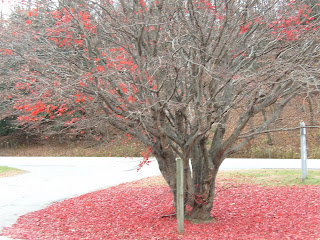Whether one thinks of the holidays this time of year in religious or secular terms--or as one big solstice metaphor for ending the dark and returning to the light--we have quite a buffet of choices in ways to celebrate.
I can remember when we didn't start thinking about Christmas until after Thanksgiving. Stores took down their turkey and pilgrim decorations--there even seemed to be a pause--and then put up their Santas. No such thing as catalogs arrived in the mail. But now, as someone phrased it, it's one long spill-way "from trick-or-treat to ho-ho-ho." A friend sent me a Christmas card one year showing a corporate Santa looking down from his office window and saying to his helper-elf: "They're starting to relax again. Switch the festive vortex up to maximum."
It does seem as if we squeeze more and more metaphorical dishes onto the table--all under the heading "Holiday Season." If there's something to show-case, enjoy, sell, let's schedule it in December, we seem to say. Church bazaars. Open studio tours. Library book sales. Sing-alongs. Locally-made craft and farmers market items--holly wreaths, clay pots, jewelry, hand-bags, fruit preserves. Store sales. Annual workplace dinners. A party or two or three. (One December back in the '80s, one or both of us went to 13 gatherings.) Or we can stay in and watch one of those seasonal dramas in which a couple of precocious kids--have you noticed, kids in today's dramas are portrayed as having more smarts than their parents?--figure how to fix up his widowed father with her divorced mother who finally recognize true love the night everyone congregates to light the village Christmas tree. There's often a little jingle of bells on the sound track to indicate that the real Santa was in the crowd working his magic. (Christmas in TV drama terms today = magic.)
Interspersed in all this--for me, at least--is a plethora of December birthdays including my own. (Once, as a child, because my birthday was so close to Christmas, my parents decided to celebrate it in June. When December came around, it didn't seem appropriate to skip it, so we did it all over again.)
But since December is a buffet, we can take our pick. What will we choose? The all-you-can eat plate with seconds and thirds? The big tree, the end-of-year letter sent out to 60 friends, the splurgy menu? Over the years, that's been my choice, and it was fun. But now I choose simple. I choose not to start the season too early--then I dash into a store and out again before yet another version of Winter Wonderland or Jingle Bells hits the sound track. I choose to play the music I love as I celebrate this return-of-the-light time of year with a nightly candle, a good book, and a glass of wine. I choose to shop at (and thus support) local independent stores. And these days (for myself, at least ... and after all my decluttering), other than something sweet like family photos, a pretty scarf, or a special hand-embroidered tea towel, I tend to prefer gifts that are consumable. You know: chocolates, candles, flowers, soaps, a pot of bulbs to bloom mid-winter. I admit to being tired of poinsettias, but amaryllis or spring bulbs beautifully pep up the days.
Without contradicting myself or getting too complicated about it, I also choose to turn the holiday into an occasion. Making brownies for the neighbors. Making the annual fruitcake with family members. Using pretty tissue and ribbon to wrap gifts. (I'm not too fond of the new method of putting things in paper bags with a dollop of tissue paper on top. But it's good for off-size things.) Hanging a gold paper star from Germany in the front door window instead of fiddling with a tree which I don't have a place for anyway. Turning berries I've kept frozen since their high summer season into a family pie. And reading 'Twas the Night Before Christmas to the little ones on Christmas Eve.
Speaking of good music, here's an enchanting two-minute link to Tchaikovsky's Sugar Plum Fairy on the perfect instrument for it--the glass harp.
What Makes December December
All of the above
Reaching the darkest-shortest days
Then starting the journey back to the lightest-longest
Transitioning from cold weather to really cold weather, aka winter
Corelli's Christmas Concerto (forgot to add it to my favorites list)
Lots of birthdays
Thinking ahead to a fresh year and a little restructuring


















